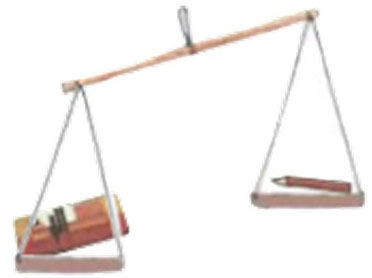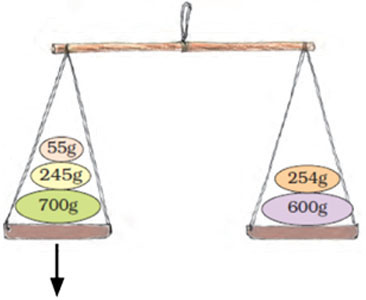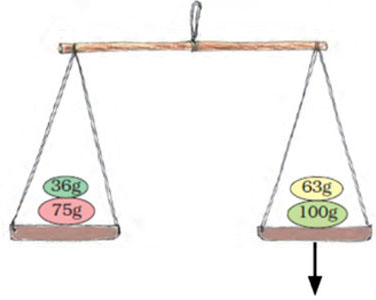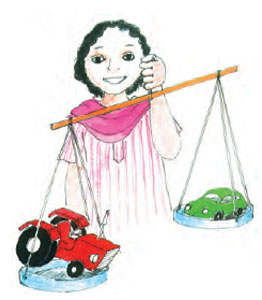NCERT Solutions For Class 4 Maths Chapter 12 - How Heavy How Light
This chapter measuring weights using balance in kilograms and grams, addition and subtraction of weights The solutions for Math-Magic Chapter-12 have been created and verified by our experienced subject matter experts, according to the CBSE syllabus and guidelines of NCERT. For practice, our subject matter experts have created very interactive, activity-based, and Image-based worksheets on these topics to enhance learning.
Download PDF For NCERT Solutions for Maths How Heavy? How Light?
The NCERT Solutions For Class 4 Maths Chapter 12 - How Heavy How Light are tailored to help the students master the concepts that are key to success in their classrooms. The solutions given in the PDF are developed by experts and correlate with the CBSE syllabus of 2023-2024. These solutions provide thorough explanations with a step-by-step approach to solving problems. Students can easily get a hold of the subject and learn the basics with a deeper understanding. Additionally, they can practice better, be confident, and perform well in their examinations with the support of this PDF.
Download PDF
Access Answers to NCERT Solutions For Class 4 Maths Chapter 12 - How Heavy How Light
Students can access the NCERT Solutions For Class 4 Maths Chapter 12 - How Heavy How Light. Curated by experts according to the CBSE syllabus for 2023–2024, these step-by-step solutions make Maths much easier to understand and learn for the students. These solutions can be used in practice by students to attain skills in solving problems, reinforce important learning objectives, and be well-prepared for tests.
How Heavy? How light?
Which things should be removed so that the weight of the load is not more than 700 kgs?
Total weight loaded in the cart is 845 kg.
835 – 700 = 135
Hence, things that will together weigh 135 kg or more should be removed from the cart. Answers may vary. One example is:
The weight of 3 sacks of rice is 105 kg, 4 chairs are 20 kg and a bamboo ladder is 10 kg. Since, 105 + 20 + 10 = 135, therefore these items can be removed so that the weight of the load is not more than 700 kgs.
Now you also make your own balance. Write down how you made it. Also draw a picture of your balance in the box below.

Make a balance on your own and write down the steps to make the balance. Also, draw the picture of the balance you have made. Answers may vary from student to student.
Mannu and Jaiju put a pencil and a geometry box in the two pans of the balance. Which pan will go down? Why? Draw a picture to show it.
The pan with the geometry box will go down because the weight of the geometry box is more than the weight of the pencil.

Make pairs of different things and use the balance to decide which is heavier. First guess which thing will take the pan down and then check with your balance.
Answers may vary based on the pair of things you select. Select the pairs of different things and observe their weight to answer this question.
Can you find your own weight using this balance?
No, this balance is not used to find your weight.
The soap weighs ____________ grams (g).
Answers may vary. In general, the weight of a small soap is 50 grams.
Close the packet with a rubber band or string. Now stick a strip of paper and write '____ g' on it.
The weight of the packet is equal to the weight of the soap. The answer will vary based on your previous answer.
If you put the soap and the weight you just made together in a pan, how many grams will both of these weighs?
The total weight will be equal to the sum of the weight of the soap and the sand packet. Answers will vary based on your previous answer. A sample answer is:
Weight of the soap is 50 g. Weight of the packet is 50 g. Therefore, the total weight is
50 + 50 = 100 g.
Now make different weights – 150 g, 200 g and 250 g. You can use soaps of different weights for this. Also make some bigger weights of 500 g, 1000 g, and 750 g. Use your weights to weigh different things and write in your notebook.
Perform the activity on your own as directed.
Make groups of three things. For example — eraser, ball, and paper. Use the balance to arrange them in order of weight – the lightest, the one with an in-between weight, and the heaviest. Complete the table with at least five examples.

Select three things and group them according to their weights as – the lightest, the one with an in-between weight, and the heaviest. Answers may vary based on the things. A sample answer is:

Find out the total weight they had loaded on the cart.

Items loaded in the carts are – a water tank, five sacks of wheat, three tables, an almirah, four chairs, two mattresses, three sacks of rice, a bamboo ladder, and pots and pans.
Step 1: Weight of 1 sack of wheat is 100 kg. Therefore, the weight of 5 sacks of wheat is 5 × 100 = 500 kg.
Step 2: Weight of 1 table is 10 kg. Therefore, the weight of 3 tables is 3 × 10 = 30 kg.
Step 3: Weight of 1 chair is 5 kg. Therefore, the weight of 4 chairs is 5 × 4 = 20 kg.
Step 4: Weight of 1 mattress is 20 kg. Therefore, the weight of 2 mattresses is 2 × 20 = 40 kg.
Step 5: Weight of 1 sack of rice is 35 kg. Therefore, the weight of 3 sacks of rice is 3 × 35 = 105 kg.
Step 6: Draw a table and enter the items loaded in the cart and their weights.
| Thing loaded | Weight |
| Water tank | 50 Kg |
| 5 sacks of wheat | 500 Kg |
| 3 tables | 30 Kg |
| An almirah | 70 Kg |
| 4 chairs | 20 Kg |
| 2 mattresses | 40 Kg |
| 3 sacks of rice | 105 Kg |
| A bamboo ladder | 10 Kg |
| Pots and pans | 10 kg |
Step 7: Add all the weights to get the total weights. 50 + 500 + 30 + 70 + 20 + 40 + 105 + 10 + 10 = 835 kg Therefore, the total weight loaded in the cart is 835 kg.
Practice Time
Which pan of the balance will go down? Show by drawing an arrow.

Step 1: Add 700, 245 and 55 to get the total weight on the left pan.
700 + 245 + 55 = 1000 g
Step 2: Add 66 and 254 to get the total weight on the right pan.
600 + 254 = 854 g
Step 3: The weight on the left pan is more than the weight on the right pan. Therefore, the left pan will go down.

Name 5 things that we usually buy—

Answers may vary based on the items that you buy regularly. A sample answer is:

Which pan of the balance will go down? Show by drawing an arrow.

Step 1: Add 200 and 105 to get the total weight on the left pan.
200 + 105 = 305 g
Step 2: Add 250 and 150 to get the total weight on the right pan.
250 + 150 = 400 g
Step 3: The weight on the right pan is more than the weight on the left pan. Therefore, the right pan will go down.

How much does an inland letter cost?
An inland letter is for Rs 2.50 that is 2 rupee and 50 paise.
Is the weight on any of the pans equal to 1 kilogram? Mark it.
We know that 1000 g = 1 kg. Therefore, the weight on the left pan of the third balance is equal to 1 kilogram.

How many grams are there in 1 kg?
There are 1000 grams in 1 kilogram.
1 kg = 1000 g.
Which is heavier — one kilogram cotton or one kilogram iron?
One kilogram weight is the same for both iron and cotton. So, 1 kg iron and 1 kg cotton both are equal in weight
Ritu is weighing her toys. She wants to know if her tractor is heavier than her car. How would you help her to find out quickly?
Ritu should place the car and the tractor on each of the pan of a balance. The pan with the toy that goes down will be heavier.
Guess which is the heaviest — a real car, a bus or a tractor?
A bus is the heaviest when compared to a car or tractor.
Which is the heaviest thing you have seen?
Answer this question based on your experience. Answers may vary. One example is:
The heaviest thing that I have seen is a train.
Now imagine what happened next and complete the story. Discuss with your friends how Vaidika's daughter found the weight of the elephant.
Answer the question based on your observation and the discussion with your friends. Answers may vary. One example to complete the story is as follows:
After marking the new water level in the boat, she removed the elephant. As the elephant was removed from the boat the water level on the boat went back to its first marking. Then she asked the king to put gold on the boat until the water on the boat reached the new level again. Thus, the weight of the elephant will be equal to the weight of the gold.
Now you show how Abdu will use these stone pieces to weigh—
a) 4 kg of firewood


To weigh 4 kg of firewood, Abdu should keep 6 kg stone on one of the pans and 2 kg stone along with the firewood on the other pan until balanced.
b) 3 kg of firewood

To weigh 3 kg of firewood, Abdu should keep 5 kg stone on one of the pans and 2 kg stone along with the firewood on the other pan until balanced.
c) 7 kg of firewood

To weigh 7 kg of firewood, Abdu should keep 5 kg and 2 kg stones on one of the pans and the firewood on the other pan until balanced.
Have you ever been to a post office?
Answer the question based on your experience. Answers may vary.
What different things do people go there for?
Some of the reasons for which people visit post office are:
• To send money orders, parcels.
• To post letters.
• To purchase envelopes, stamps, etc.
• For banking.
How much does a postcard cost?

A single post card is for Rs 0.50, that is 50 paise, and a printed post card is for Rs 6.00.
Look at the postal rates given in the chart.
1. How much will you have to pay for stamps on a letter weighing 50 grams?
The weight of the letter is 5 g which can be divided as
20 g + 20 g + 10 g
The cost of stamps for 20 g letter is Rs 5.00.
The cost of stamps for every additional 20 g is Rs 2.00. Therefore, the cost of stamps for 50 g letter will be
5 + 2 + 2 = Rs. 9
Hence, one has to pay Rs 9.00 for stamps on a letter weighing 50 grams.
2. Akash wants to send a parcel of the Math Magic textbook to his friend Rani in Chennai. The book weighs 200 g. See the chart to find the cost of posting the book.
The weight of the book is 200 g which can be divided as
50 g + 50 g + 50 g + 50 g
The cost of stamps for a 50 g parcel is Rs 5.00.
The cost of stamps for every additional 50 g parcel is Rs 3.00.
Therefore, the cost of stamps for a 200 g book is
5 + 3 + 3 + 3 = Rs 14
Hence, the cost of posting a 200 g book is Rs 14.
Rahul needs stamps of Rupees 25 for his parcel. He went to the post office. Only stamps of Rs 1, Rs 2, Rs 5 and Rs 10 were there at that time. Using those stamps in how many different ways can he make Rs 25. Can you show five different ways?
He can make Rs 25 using Re 1, Rs 2, Rs 5 and Rs 10 in many ways. Answers may vary. Following are some possible ways:
• Rs 10 + Rs 10 + Rs 5
• Rs 10 + Rs 5 + Rs 5 + Rs 5
• Rs 10 + Rs 10 + Rs 2 + Rs 2 + Re 1
• Rs 5 + Rs 5 + Rs 5 + Rs 5 + Rs 5
• Rs 5 + Rs 5 + Rs 5 + Rs 5 + Rs 2 + Rs 2 + Re 1
What is the heaviest parcel he can send using stamps of Rs 25?
The cost of stamps for a 50 g parcel is Rs 5.00. The cost of stamps for an additional 50 g parcel is Rs 3.00.
Rs 25 can be divided as
Rs 5 + Rs 3 + Rs 3 + Rs 3 + Rs 3 + Rs 3 + Rs 3 + Rs 2.
So, the maximum weight of the parcel can be
50 g + 50 g + 50 g + 50 g + 50 g + 50 g + 50 g = 350 g.
What happened after that? So, what was the answer the crow wanted to give?
As the crow opened his beak to answer, the frog escaped from his mouth. The answer that the crow wanted to give was 650 g + 145 g = 795 g.
Now, you also fill the table by finding out the age, height, and weight of any five friends.

Complete the table based on the information provided by your friends. Answers may vary.
Which pan of the balance will go down? Show by drawing an arrow.

Step 1: Add 196 and 20 to get the total weight on the left pan.
196 + 20 = 216 g
Step 2: The weight on the left pan is more than the weight on the right pan. Therefore, the left pan will go down. Mark an arrow on the left pan.

Which pan of the balance will go down? Show by drawing an arrow.

Step 1: Add 75 and 36 to get the total weight on the left pan.
75 + 36 = 111 g
Step 2: Add 100 and 63 to get the total weight on the right pan.
100 + 63 = 163 g
Step 3: The weight on the right pan is more than the weight on the left pan. Therefore, the right pan will go down.

If I put 2 cars, will the tractor still be heavier?

Two cars will increase the weight of the right pan and so the tractor will not be heavier.
Which pan of the balance will go down? Show by drawing an arrow.

Step 1: Add 75 and 75 to get the total weight on the left pan.
75 + 75 = 150 g
Step 2: Add 140 and 35 to get the total weight on the right pan.
140 + 35 = 175 g
Step 3: The weight on the right pan is more than the weight on the left pan. Therefore, the right pan will go down.

Guess and write the weight of each thing he bought—in g or kg.

The correct answer is:
| Items | Weight |
| Rice | 5 kg |
| sugar | 10 kg |
| Mustard seeds | 1 Kg |
| wheat | 3 Kg |
| Dal | 500g |
| Tea | 250g |
| Pepper | 25g |
Anamika wants to weigh this chair using the weighing machine.
Can you suggest a way for doing this?


Answers may vary student to student. One sample answer is:
To weigh the chair using the weighing machine Anamika needs a flat slab. First, she should keep the slab on the weighing machine and record its weight. Then she should place the chair on the slab that is already on top of the weighing machine and then record the weight of the chair and the slab together.
Thus, the weight of the chair will be equal to the difference between the weight of the chair and the slab together and the weight of the slab alone.
3. Read the weight shown in the picture. Find out the cost of sending a parcel of that weight:
Parcel Weight?
Cost of stamps?

Observe the given picture, the weighing machine shows that the weight of the parcel is 225 g which can be divided as
50 g + 50 g + 50 g + 50 g + 25 g.
The cost of stamps for a 50 g parcel is Rs 5.00.
The cost of stamps for every additional 50 g parcel is Rs 2.00.
Therefore, the cost of stamps for a 225 g item is
5 + 3 + 3 + 3 + 3 = Rs 17
Hence, the cost of stamps is Rs 17.
How many oranges balance the weight in the third?

From the first balance:
Weight of 1 orange and 1 mango is equal to the weight of 3 oranges. Therefore, the weight of 1 mango is equal to the weight of 2 oranges. From the second balance:
Weight of 2 papayas is equal to the weight of 2 oranges and 1 mango. Since the weight of 1 mango is equal to the weight of 2 oranges, the weight of 2 papayas is equal to the weight of 4 oranges.
Therefore, the weight of 1 papaya is equal to the weight of 2 oranges. Now, the weight of 1 papaya is equal to the weight of 2 oranges and the weight of 1 mango is equal to the weight of 2 oranges.
Therefore, the weight of 1 papaya and 1 mango is equal to the weight of 2 + 2 = 4 oranges.
Hence, 4 oranges will balance the weigh

There are 3 marbles of the same size but one marble is slightly heavier or lighter than the other two. Can you find which is that marble and if it is heavier or lighter? You can use a balance only two times.

Consider the yellow, red, and blue marble as Y, R, and B respectively. At first take Y and R and put them on the pans of a balance. Two cases may arise, either it is balanced or unbalanced.
Case 1: The weights are balanced.
The weights of R and Y are equal. Therefore, B is the marble which is either heavier or lighter.
Now, put B and Y on either side of the balance and observe the weight. If the pan with B goes down, then B is the heavier marble. If the pan with Y goes down, then B is the lighter marble.
Case 2: Weights are unbalanced.
If the weight of Y is less than R, put R and B on the balance. If R and B are equal, Y is the lighter marble. If B is lighter than R, R is the heavier marble.
If the weight of Y is greater than R, put R and B on the balance.
If R and B are equal, Y is the heavier marble. If B is heavier than R, R is the lighter marble.
Frequently Asked Questions
The NCERT solution for Class 4 Chapter 12: How Heavy How Light is important as it provides a structured approach to learning, ensuring that students develop a strong understanding of foundational concepts early in their academic journey. By mastering these basics, students can build confidence and readiness for tackling more difficult concepts in their further education.
Yes, the NCERT solution for Class 4 Chapter 12: How Heavy How Light is quite useful for students in preparing for their exams. The solutions are simple, clear, and concise allowing students to understand them better. They can solve the practice questions and exercises that allow them to get exam-ready in no time.
You can get all the NCERT solutions for Class 4 Maths Chapter 12 from the official website of the Orchids International School. These solutions are tailored by subject matter experts and are very easy to understand.
Yes, students must practice all the questions provided in the NCERT solution for Class 4 Maths Chapter 12: How Heavy How Light as it will help them gain a comprehensive understanding of the concept, identify their weak areas, and strengthen their preparation.
Students can utilize the NCERT solution for Class 4 Maths Chapter 12 effectively by practicing the solutions regularly. Solve the exercises and practice questions given in the solution.

